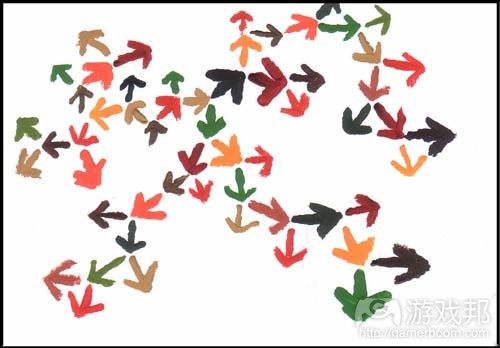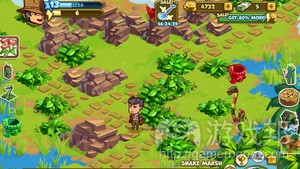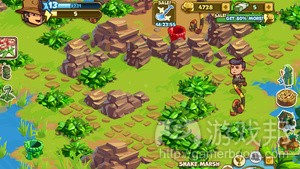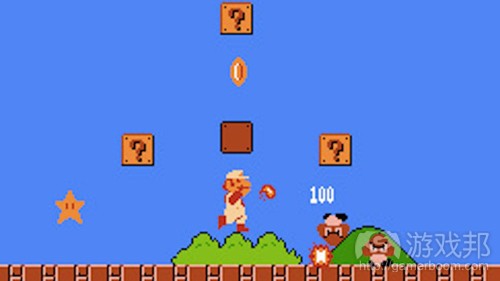好游戏应为玩家提供一系列有趣的选择
作者:Stephen Totilo
在我玩电子游戏的头25年中,我并不知道制作出色的电子游戏需要遵从哪些理论。我只感觉得到哪些是好游戏。
去年我被迫为此总结一个理论——制作出色电子游戏的理论。我的理论很简单,无论是射击、开飞机、跳过蘑菇、解决谜题还是翻转降落方块,游戏对玩家来说就是一系列的选择。优秀电子游戏会为玩家呈现一系列有趣的选择。如果游戏的选择很无趣,或者它们根本就不能算是选择,那么这款游戏就很糟糕。
2011年的一些事件让我不得不开始为制作好游戏而提炼一些理论。这些事件与Zynga有关,当时我听说Zynga游戏不过是利用一些心理伎俩诱使玩家持续玩游戏,而非通过娱乐玩家鼓励其体验游戏。我听说有成百上千万玩家拥护Zynga游戏,但这些玩家并不知道这些游戏对自己有什么好处。有评论直言,Zynga所做的东西非但不能称为坏游戏,甚至连游戏都算不上。
而令人尴尬的是,Zynga在整个2011年基本上每月都邀请我去体验他们的游戏,因为我在一家主流电子游戏网站任职,他们希望我能为其游戏发表积极的报道和评价。我当时并不想玩他们的游戏,但作为新闻记者我又不能将信息拒之门外,所以我每月都回复他们,我会试试你们的游戏。
在此之前,我仅玩过几分钟的《FarmVille》,这款游戏一开始时并没有呈现什么让我感兴趣的选择。它只是将我推向一步接一步的操作,告诉我要建设什么,搜集什么,等待什么,我在其中完全没有自主做决定的感觉。这款游戏让我觉得无聊。
后来Zynga又向我展示了《FrontierVille》,他们向我讲述了游戏的故事。但这也并没有让我心生向往。他们又跟我推荐了《Empires & Allies》(借鉴了《Advance Wars》的一些灵感),我从其中的战斗系统中意识到,玩家可能会输掉战斗。输掉的玩家必须有一个走向胜利或失败的选择,我对这款游戏较有兴趣,但试过之后很快就厌烦了。
后来我又试玩了《Adventure World》(游戏邦注:Zynga后来将该游戏更名为《Indiana Jones Aventure》,游戏中的主角很讨厌蛇,其中的一场与蛇相遇的情况则让我相信,《Adventure World》不但算得上游戏,而且还有成为好游戏的潜力。
我将通过以下截图重现我初试游戏所遇到的情况:
首先,我进入游戏中的一个地图并发现我可以选择自己要去的一个地方。在画面左上方有一条路,可以将我引到一个灌木丛,但我需要斩荆披棘地破开这条路。我不知道其中可能隐藏了什么东西。而右边的这条路则将把我引向一个红色的宝物,但旁边有一条蛇在虎视眈眈,随时可能向我扑来。
我选择走向宝物所在之处,也就是说走向那条蛇。
我拿到了宝物,蛇也向我靠近。
我决定与蛇拼命而非逃之夭夭,我发现这条蛇很容易解决,就将它杀死了。
这在电子游戏史上不算什么最具吸引力的选择,但它们毕竟还是选择。它们是可以直接引向明显结果的选择,这引起了我的兴趣。
而当Zynga成员又让我去玩《Mafia Wars 2》时,我就知道自己要找的是什么了——选择。我认为,游戏中的选择越多越好,至少对Zynga来说是这样。我认为Zynga成员越来越进步了。他们不再制作一些没有分支的流程图表让用户点击,他们也开始懂得为玩家提供分支,他们提供了一些拥有明显结果的选择。
《俄罗斯方块》为何能成为经典?
我认为电子游戏必须存在选择的这个想法成形后,我开始从自己最喜欢的电子游戏中寻找不同之处。我喜欢《Metroids》和《刺客信条》,这两者无疑都是算是电子游戏。虽然《赛尔达传说:梅祖拉的面具》是我最喜欢的电子游戏,但我认为史上最出色的电子游戏当属《俄罗斯方块》。我所列出的这些游戏都能够支持我这个理论,而《俄罗斯方块》在这一点上的表现更为明显,这也是它为何是最佳游戏的原因。游戏中的每个下坠的方块都呈现了一些有趣的选择:我该向哪放置这个方块?我是否能快速翻转它?还是该让它迅速到位?下一个方块是什么,我当前放置的方块对它有什么影响……这些选择很快呈现并且很明确。其结果有时候是立即呈现,有时候会延迟出现。但它们都很明显。
这款游戏并只是一些下坠的方块,而是一连串做出决定的机会。
Merihari和叉子
我征求了自己所知的一些杰出电子游戏开发者的看法,询问他们判断好坏游戏的标准。我的理论是好游戏会呈现有趣的选择,那么他们的理论又是什么呢?
身在日本的Dylan Cuthbert(游戏邦注:他曾参与开发《Star Fox》、《PixelJunk Monsters》和《Digidrive》等游戏,并与曾与任天堂京都总部的一些高层合作)通过电子邮件表示,“这是一个见仁见智的问题。例如,我认为《暗黑之魂》是杰出的游戏,但其他人可能另有看法。不过,真正的好游戏总有一些共同特点。对我来说,这些特点包括美感(不局限于美术设计),优化、粘性、原创性和‘Merihari’”。
“你可能会问什么是’Merihari’,它是一个日本词,包含节奏+平衡+分配——例如,坐过山车的时候如果缺了Merihari,那就只是在进行持续的下坡。这听起来可能不错,但如果没有最初攀升时的那种紧张感,这种体验就会丧失大量的刺激性。这也是为何游戏中的boss战斗能够发挥作用的原因。在遭遇boss之前要先塑造一种紧张感。如果你的游戏只有boss战斗,这种体验就会很肤浅”。(这让我想起了出自Polyphony之手的《Omega Boost》,如果它在boss战斗前营造了足够的紧张感,可能会是一款更好的游戏)
“最主要的因素,我想就是热爱与在乎——如果整个开发团队都热爱并且在乎这款游戏,只要具备这一点就可以制作出很棒的游戏。”
Merihari这个理念听起来不错。那么我要改一下这个理论:有趣的决策+Merihari。但也许还可以再添加其他元素。
身在纽约的游戏设计师兼学者Eric Zimmerman的回答是:
“我认为这个问题的答案无法简单概括,比如我们不能说哪种特定的游戏设计或特定的玩家体验就是好的。我认为构成出色的玩家体验的元素是设计本身的问题之一。游戏设计师需自己决定游戏成功的方向,并据此设计游戏。”
“比起其他领域的设计师(例如建筑师或工业设计师),让设计师定义自己的设计问题对游戏设计师而言尤为重要,因为我们的工作没有那么明显的功利性。叉子设计师通常要以叉子的用途来定义其设计的成功:叉子是让人用来吃东西的”。
“但在游戏设计中,我们得自己制定成功的标准。这可能包括美学目标,探索或传送思想的目标,商业标准以及技术创新性等。当然,所有的这些目标都是非游戏设计师也需要考虑的东西。例如,叉子设计师也会有自己的美学目标。但对非教育类游戏来说,这些非功用性目标就是我们的追求。”
“所以游戏好坏应由游戏设计师自主决定。而各个设计师又有不同的判断标准,一款游戏之所以优秀可能是因为它触动你的悲伤、快乐或愤怒的情感。因为它让玩家放松或者兴奋,或者将他们引入一个禅宗境界,或者让他们提高解决问题的灵敏性。游戏设计师可以决定游戏的成功是来自友爱的社交互动,不知所云的聊天,还是孤立感。这种成功也可能与新型暴力元素有关,或者是对小提琴的新诠释。通常情况下,这是许多不同甚至有时相互矛盾的元素所融合的成功标准。”
这让我想起了我自己最初的困惑——这个困惑并非如何区分游戏的好坏,而是如何定义某些事物(尤其是Zynga公司的产品)究竟算不算游戏。Zimmerman并没有特别解释这一点,但他的评论却让我幡然醒悟,我终于知道为什么玩Zynga游戏难以让我放松——我在这些游戏中每做一个决定,游戏就会明显暴露出开发者希望用户付费的意图。我每做一个决定,都得使用一定的能量,都会让我更近一步走向不得不等待的时刻(这让人很烦),要不就得去骚扰好友以求获得帮助(这让我看起来像是在替Zynga推广游戏),或者付费购买更多能量。
这里可能得再修正一下我的理论:优秀的电子游戏不但要包含有趣的决策,而且这些决策不能让我感觉自己像是被操纵/利用/敲竹竿。
《超级马里奥》中的决策
在2012年,我带着自己的理论寻找那些充满选择的游戏。Zynga成员仍在向我推荐他们的游戏。如果这些游戏并不能提供我之前所体验到的那些选择——或者并没有提供具有直接结果的选择,我就会失去兴趣。
在这一过程中,我发现自己偏爱第一人称射击游戏,但对那些具有线性特点,并不提供解决问题的选择的游戏没有多大兴趣(这也是为何我特喜欢2011年的《子弹风暴》的原因,游戏中的每场敌人遭遇战都提供了大量获胜的选择)。
我意识到自己比较难以接受日本角色扮演游戏,可能就是因为它们所呈现的故事缺乏选择(这也是为何我喜欢《Fire Emblems》,并且排斥刷任务机制的原因)。
我喜欢《愤怒的小鸟太空版》,但对选择有限的《Ace Attorney》不感兴趣也正是因为,我追求的是具有交互性的决策制定元素。
我现在很乐衷于在游戏中做截然不同的选择,然后看看游戏会出现什么结果。如果我觉得自己像是被迫去做特定的事情,我就会很抵触,很气恼。我会讨厌这种游戏。这也正是为何我去年爱玩《传送门2》的原因,它的每个谜题可能只有一个解决方法,但却可以让我觉得自己是在制定决策。而这也能够解释为何我不喜欢《神秘海域3》,因为它只会针对相同的敌人提供同样的选择。
我寻找含有大量选择的游戏,并不意味着我只找BioWare风格,含有大量分支路径的角色扮演游戏。对我而言,一个选择可以含有两个不同的目标。它可以简单到决定是否要跳跃。
我一直深为《超级马里奥》中的跳跃动作而着迷,我认为它是电子游戏中最完美的动作,马里奥向上攀升的过程中会伴随着探索发现。向上过程中他可能会撞到将生出蘑菇或花朵的砖块。而他的下坠而是一种进攻动作,他可以踩扁敌人。将这一上一下动作结合起来,则可以跨越无底洞或躲过食肉植物。游戏关卡每一处都在为玩家呈现一连串选择,这些选择几乎都在促使玩家决定是否或如何向上跳跃,向下踩踏。
马里奥系列中的最佳关卡是由一系列障碍组成,如果玩家快速接近这些障碍,就刽同到一些令人快乐的困境。我应该跑步跳过这个人吗?但遇到下个人我该怎么办?我应该跳上这只龟并用它的壳打下一敌人,还是挨个跳过它们的脑袋?
也许呈现有趣的选择是判断好游戏的标准,这是一个极为显而易见的理论。也许这一理论并不能区分游戏优秀与出色之处。但对于我这样的游戏玩家来说,它确实让我更清楚地意识到游戏如何占用了我的时间。如果它为每分每秒都为我提供有趣的选择,我可能就会喜欢它。如果没有,我最好就不要玩这种游戏。这就是我区分好坏游戏的标准。(本文为游戏邦/gamerboom.com编译,拒绝任何不保留版权的转载,如需转载请联系:游戏邦)
The Difference Between A Good Video Game and a Bad One
Stephen Totilo
During my first 25 years playing video games I had no theory about what makes a video game good. I knew the good ones when I played them. I just felt it.
Last year, however, I was forced to come up with a theory—a theory about what makes a video game good. I’ve been testing it ever since.
My theory is simple. Whether a video game is about shooting guns, flying planes, jumping over mushrooms, solving puzzles or rotating falling blocks, the game is a series of choices for the player.
A good video game presents a series of interesting choices for the player to make. Should the game’s choices be uninteresting—should they barely be choices at all—then the game is bad.
Events in the year 2011 had forced me to come up with some sort of theory about what makes a game good. The events involved Zynga, the company behind FarmVille, CityVille and, as I understood in early 2011, much of the eVil plaguing video games. The Zynga games, I’d heard, weren’t so much games as psychological tricks that baited players to keep playing by enticing them with scheduled rewards, not by entertaining them as games should, whatever that meant. Millions of people may have enjoyed Zynga’s games, I had heard, but the thinking was that millions of people didn’t know what was good for them. These things Zynga made weren’t just bad games, the critics charged; they weren’t even games.
A good video game presents a series of interesting choices for the player to make.How awkward, then, that Zynga was courting me throughout 2011 to play their games. They did that monthly, contacting me in my capacity as an editor at major video game website in the hopes that I would pay attention to their next big game, appreciate its improvements over the last big Zynga game and wind up with something positive to report about it. I did not want to play their games, but a reporter’s job is not to stem the flow of information. Yes, I told the Zynga people month after month, I’ll try your games.
Before the Zynga courtship began, I had only played FarmVille and only for a few minutes. The beginning of the game had presented no choices that interested me. It pulled me from one action to the next, telling me what to build or collect or what to wait for, giving me no sense that I was making any decisions of my own. It had bored me.
The Zynga people showed me FrontierVille. They told me about the game’s story. That didn’t make me want to play. They told me about Empires & Allies, which borrowed ideas from an old favorite, Advance Wars. Through its combat system I recognized that a player could lose a fight. The losing player, I realized, must have had a choice to make that brought them to victory or defeat. I was more interested in this game. But I tried that one and it, too, quickly bored me.
Then I tried Adventure World, a game Zynga would eventually re-brand as an Indiana Jones aventure. The hero of that series hates snakes, but an encounter with a snake in Adventure World is what convinced me that not only was this one a game, but it had the potential to be good.
I’ve tried to recreate my moments of discovery with some screenshots.
First, I entered one of the game’s maps and realized that I had a choice of where I could go. One path, to the upper left of the frame, would bring me toward bushes through which I’d have to slash.
I had no idea if anything was hiding in them. The path to the right would bring me to a piece of red treasure but also toward a snake that was moving in a pattern of its own and might intercept me.
I chose to move toward the treasure—and toward the snake.
I grabbed the treasure, and the snake closed in.
I decided to fight instead of fleeing. I discovered it was too weak for me. I killed it.
These were not the most fascinating choices in video game history, but they were choices. They were choices that would lead to immediately distinct outcomes. They interested me.
When the Zynga people showed me their next game, Mafia Wars 2, I knew what to look for: choices. The more the merrier, at least for Zynga, I thought. The Zynga people were getting better, I had decided. They were no longer making unbranching flow charts for their customers to click through; they were beginning to offer players branches; they were serving decisions that led to distinct consequences.
What Makes Tetris Great
As my idea about choices in video games coalesced, I began to look at my favorite video games differently. I love Metroids and Assassin’s Creeds, which I never doubted were video games. The Legend of Zelda: Majora’s Mask is my favorite game, though I’m pretty sure that Tetris is the best video game ever made. All of these games support my theory, Tetris most purely among them, which is probably why it’s the best. Each falling piece presents the opportunity for some basic but almost always-interesting choices: Where will I put this piece? Can I rotate it fast enough? Should I drop it swiftly? What is the next piece coming and how will this piece set me up for dropping that one? Do I want to set myself up to score a four-line-clearing Tetris? Etc. The choices come quickly.
The choices are always clear. The consequences are sometimes immediate, sometimes delayed. They are always clear.
The game isn’t really about falling blocks; it’s about a cascade of chances to make decisions.
Merihari… and Forks
I reached out to some of the smartest video game creators that I know and I asked them how they could spot a good game and distinguish it from a bad one. My theory was that the big thing was the presence of interesting choices, but what was their theory?
Dylan Cuthbert weighed in from Japan, which thrilled me because Dylan Cuthbert not only makes many video games that I like—Star Fox, PixelJunk Monsters, Digidrive, to name a few—but he has also worked closely with the top people at Nintendo’s Kyoto headquarters where many indisputably great video games have been made.
“Well to begin with, ‘beauty is in the eye of the beholder,’” he told me over e-mail back in the beginning of the year. “For example I think Dark Souls is an amazing game but others might disagree with me. However, for any game that someone thinks is really good there are a few common factors. For me those are: Aesthetics (not just artistic beauty), Polish, Engagement, Originality and final but not least, ‘Merihari’.
“‘What’s merihar?’ you are probably asking; well it’s a Japanese word that embodies rhythm+balance+distribution—for example. imagine a roller coaster ride without merihari, and it would just be a continuous downhill ride. That may sound good, but, actually without the tension of that initial climb, a fairly large chunk of the thrill is lost. It’s why boss fights work well in games. The stage before it builds up the tension. If you have a game that only has boss fights, the experience begins to feel shallow. (a game that sticks in my mind for doing this, unfortunately, is Omega Boost from Polyphony, a game that would have been much better if it had built up the tension before each battle)
Cuthbert: “For any game that someone thinks is really good there are a few common factors. For me those are: Aesthetics (not just artistic beauty), Polish, Engagement, Originality and final but not least, ‘Merihari.’”"Probably the main thing, though, is that old favourite: tender love and care—when the entire development team has loved and cared for the game that alone can simply make all the difference.”
The merihari thing sounded right. Theory revision! Interesting decisions + merihari. Plus other stuff too, probably.
I got another response, this one from Eric Zimmerman, a game designer and academic in New York:
“I don’t think you can answer the question in simple terms, i.e. a certain kind of game design or a certain kind of player experience,” he told me in an e-mail. “I would have to answer that deciding WHAT constitutes a good experience for your players is part of the design problem itself. A game designer has to decide what success will be for her game. And then she has to design it!
“This idea of a game designer defining her own design problem is particularly salient for game designers, as opposed to other forms of designers (like architects or industrial designers) because our work is usually explicitly non-utilitarian. A fork designer can always fall back on the success of a fork design being the functional use of the fork: someone actually can use it to eat food.
Zimmerman: “Fork designers usually have their own aesthetic goals, for example. But in the case of (non-educational) games, the non-functional goals are ALL THAT WE HAVE.”"But in game design, we have to create our own criteria for success. This might include aesthetic goals, goals for exploring or conveying ideas, commercial metrics, and technical innovations, etc. Of course, all of these kinds of goals are things that non-game designers can take on, too. Fork designers usually have their own aesthetic goals, for example. But in the case of (non-educational) games, the non-functional goals are ALL THAT WE HAVE.
“So game designers themselves decide what makes a good game good. And it can be unique for each individual designer, and for each individual game a designer might make. A game might be good because it makes you sad, or happy, or angry. It might be meant to relax players, or excite them, to grind them into a zen state or snap them into problem-solving alertness. A game designer might decide success is loving social interaction, or ruthless trash talking, or solitary isolation. Or success might be thinking about violence in a new way—or maybe thinking about violins in a new way.
Usually it is a stewy mix of a whole bunch of different and sometimes conflicting success criteria.
“And a designer’s idea of what success looks like for a game can even change as the game is being developed or after it is released. In fact the sweetest pleasure for a game designer can be seeing your game played in ways you never anticipated. That’s when your players teach YOU about what makes a good game good.”
This seems right as well, and helped remind me of my original quandary, which wasn’t to distinguish between good games and bad ones but to determine if something—specifically, the creations of the Zynga corporation—were games at all. Zimmerman did not address that specifically, but his comments about the goals of games helped me realize what it is that Zynga’s big FacebookVille games possess that makes it so hard for me to relax and just play them: their goal of making money for the people who created the game feels apparent every time I make a decision in one of those games.
Every time I make a decision, I use one of my rationed pieces of energy, bringing me another step closer to having to wait to continue (that’s annoying) or to bug my friends for help (that makes me feels like I’m marketing the game for Zynga) or paying for more energy (that feels like I’m losing a test of wills with a rich corporation).
Possible theory revision: A good video game not only contains interesting decisions but doesn’t include decisions that make me feel like I’m being manipulated/used/nickel-and-dimed.
Super Mario Decision-Making
In 2012, armed with my theory I’ve been looking for games that are full of choices. The Zynga people still call, and they still show me their games. If the game doesn’t appear to offer choices I haven’t been offered before—or if it doesn’t offer choices that lead to distinct consequences—I lose interest.
As I’ve hunted for games full of choices, I’ve honed my taste in first-person shooters and realized that I’m less interested in the ones that feel as if they pull me down a straight line and not give me a choice how to solve my problems (so that’s why I liked 2011′s Bulletstorm so much… every enemy encounter was ripe with multiple choices about how to win it).
I’ve realized that my low tolerance for Japanese role-playing games might be less due to the stories they present than to the lack of choices available in the ones I’ve played (so that’s why the Fire Emblems are my favorites and why I despise level-grinding, the epitome of the uninteresting choice of how to spend your time).
My zeal for interactive decision-making has enhanced my appreciation for Angry Birds Space and explained my limited interest in the wonderfully-written but choice-limited Ace Attorney games.
I now crave from the games I play the choice to do radically different things to see what happens next. If I feel like I’m being funneled or forced to do only a certain thing next, I resist. I get annoyed. I dislike the game. This must be why I loved Portal 2 last year, a game that may have had just one solution to each of its puzzles but let me feel like I was experimenting—making decisions—as I tinkered with possible ways through. And this must be why I tired of Uncharted 3′s combat, which offered me the same choices against the same enemies ad nauseum.
When I say I now look for games that are filled with choices, I don’t mean that I’m always looking for BioWare-style role-playing games that are full of branching moral paths. For me, choice can involve having two different targets to shoot. It can involve something as simple and pure and being posed with the quandary of whether or not to jump.
A Mario level rushed through briskly is an encounter with a series of interesting choices.I’ve always been fascinated by the act of jumping in Super Mario Bros.. I consider it the most perfect activity ever put in a video game (how strange that it’s not in Tetris!). Mario’s ascent is associated with discovery. On his way up he might hit a block that will sprout a mushroom or flower that grants him new abilities. His descent is an attack. On his way down he squashes his enemies. When combined, the ascent and descent are also a necessary means of traversal used to pass bottomless pits or avoid carnivorous plants that emerge from green pipes. Every inch of a Mario level presents the player a string of choices, almost all of which compel the player to decide whether or how to use the ascent, the descent or both to one’s advantage.
A Mario level rushed through briskly is an encounter with a series of interesting choices. The best levels in the series are composed of a series of obstacles that, when approached rapidly, offer a delightful set of quandaries. Do I run and jump over this guy? But then what does that put me in a position to do to the next guy? Do I take this upper path? But then do I miss the power-up that was hidden below? Do I hope on this turtle and knock its shell into the next few enemies, do I hop across each of their heads? Etc.
Perhaps this idea of good games that present interesting choices is too obvious a theory. Perhaps it does not sufficiently sift gaming’s good works from its bad, to say nothing of distinguishing between gaming’s good work and its greats. The theory has aided me, though, because it has helped me respect myself as a gamer and made me more conscious of how a game will use my time. If it offers me interesting choices, second by second and minute by minute, I may enjoy it. If it does not, I’d have been better off not playing it. This is how I now distinguish the good games from what I believe are the bad.(source:kotaku)














































 闽公网安备35020302001549号
闽公网安备35020302001549号